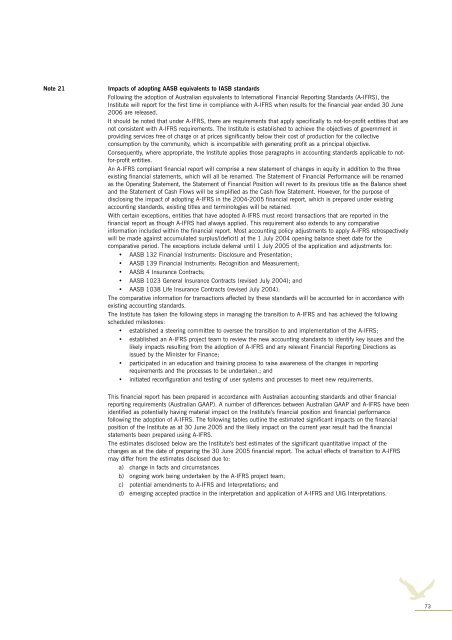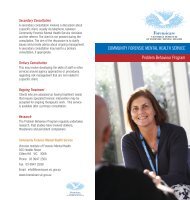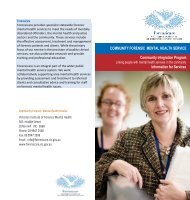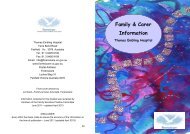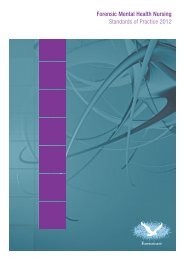Annual Report 2004-2005 - Forensicare
Annual Report 2004-2005 - Forensicare
Annual Report 2004-2005 - Forensicare
Create successful ePaper yourself
Turn your PDF publications into a flip-book with our unique Google optimized e-Paper software.
Note 21<br />
Impacts of adopting AASB equivalents to IASB standards<br />
Following the adoption of Australian equivalents to International Financial <strong>Report</strong>ing Standards (A-IFRS), the<br />
Institute will report for the first time in compliance with A-IFRS when results for the financial year ended 30 June<br />
2006 are released.<br />
It should be noted that under A-IFRS, there are requirements that apply specifically to not-for-profit entities that are<br />
not consistent with A-IFRS requirements. The Institute is established to achieve the objectives of government in<br />
providing services free of charge or at prices significantly below their cost of production for the collective<br />
consumption by the community, which is incompatible with generating profit as a principal objective.<br />
Consequently, where appropriate, the Institute applies those paragraphs in accounting standards applicable to notfor-profit<br />
entities.<br />
An A-IFRS compliant financial report will comprise a new statement of changes in equity in addition to the three<br />
existing financial statements, which will all be renamed. The Statement of Financial Performance will be renamed<br />
as the Operating Statement, the Statement of Financial Position will revert to its previous title as the Balance sheet<br />
and the Statement of Cash Flows will be simplified as the Cash flow Statement. However, for the purpose of<br />
disclosing the impact of adopting A-IFRS in the <strong>2004</strong>-<strong>2005</strong> financial report, which is prepared under existing<br />
accounting standards, existing titles and terminologies will be retained.<br />
With certain exceptions, entities that have adopted A-IFRS must record transactions that are reported in the<br />
financial report as though A-IFRS had always applied. This requirement also extends to any comparative<br />
information included within the financial report. Most accounting policy adjustments to apply A-IFRS retrospectively<br />
will be made against accumulated surplus/(deficit) at the 1 July <strong>2004</strong> opening balance sheet date for the<br />
comparative period. The exceptions include deferral until 1 July <strong>2005</strong> of the application and adjustments for:<br />
• AASB 132 Financial Instruments: Disclosure and Presentation;<br />
• AASB 139 Financial Instruments: Recognition and Measurement;<br />
• AASB 4 Insurance Contracts;<br />
• AASB 1023 General Insurance Contracts (revised July <strong>2004</strong>); and<br />
• AASB 1038 Life Insurance Contracts (revised July <strong>2004</strong>).<br />
The comparative information for transactions affected by these standards will be accounted for in accordance with<br />
existing accounting standards.<br />
The Institute has taken the following steps in managing the transition to A-IFRS and has achieved the following<br />
scheduled milestones:<br />
• established a steering committee to oversee the transition to and implementation of the A-IFRS;<br />
• established an A-IFRS project team to review the new accounting standards to identify key issues and the<br />
likely impacts resulting from the adoption of A-IFRS and any relevant Financial <strong>Report</strong>ing Directions as<br />
issued by the Minister for Finance;<br />
• participated in an education and training process to raise awareness of the changes in reporting<br />
requirements and the processes to be undertaken.; and<br />
• initiated reconfiguration and testing of user systems and processes to meet new requirements.<br />
This financial report has been prepared in accordance with Australian accounting standards and other financial<br />
reporting requirements (Australian GAAP). A number of differences between Australian GAAP and A-IFRS have been<br />
identified as potentially having material impact on the Institute’s financial position and financial performance<br />
following the adoption of A-IFRS. The following tables outline the estimated significant impacts on the financial<br />
position of the Institute as at 30 June <strong>2005</strong> and the likely impact on the current year result had the financial<br />
statements been prepared using A-IFRS.<br />
The estimates disclosed below are the Institute’s best estimates of the significant quantitative impact of the<br />
changes as at the date of preparing the 30 June <strong>2005</strong> financial report. The actual effects of transition to A-IFRS<br />
may differ from the estimates disclosed due to:<br />
a) change in facts and circumstances<br />
b) ongoing work being undertaken by the A-IFRS project team;<br />
c) potential amendments to A-IFRS and Interpretations; and<br />
d) emerging accepted practice in the interpretation and application of A-IFRS and UIG Interpretations.<br />
73


